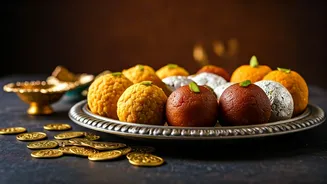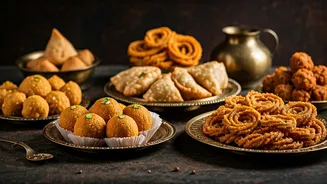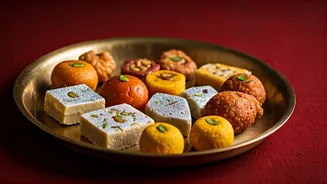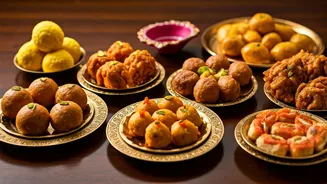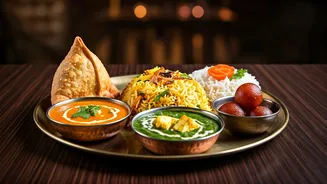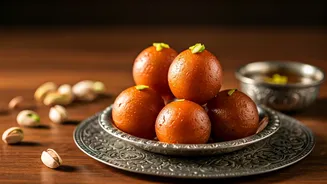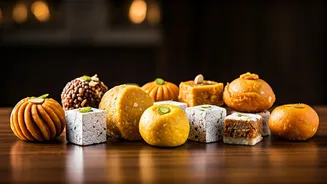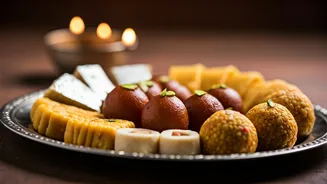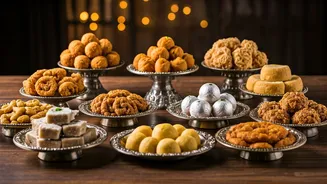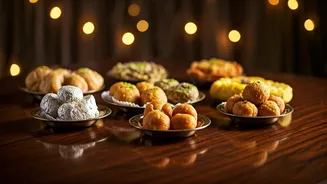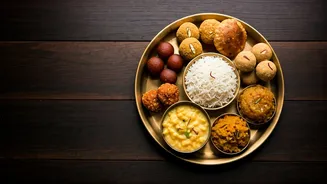Sweet Beginnings: Ladoos
Ladoos, round sweets often made from gram flour, semolina, or wheat flour, are a staple during Diwali. These sweets symbolize happiness, prosperity, and
auspicious beginnings. There are many variations, including besan ladoo, motichoor ladoo, and coconut ladoo. Consuming ladoos on Diwali is believed to attract positive energy and good luck. The preparation of ladoos often involves family members, making it a communal activity that strengthens bonds. This sweet treat is not merely a dessert; it’s a symbol of the sweetness that the festival of lights brings into one’s life. The sharing of ladoos with family and friends further embodies the spirit of Diwali, promoting togetherness and generosity. The act of making and offering ladoos is also seen as a gesture of inviting prosperity and blessings into the home.
The Richness of Kheer
Kheer, a creamy rice pudding, holds a significant place in Diwali celebrations. This dessert, made with rice, milk, sugar, and often flavored with cardamom and nuts, signifies prosperity and abundance. The milky texture and the presence of rice represent fullness and contentment. Kheer is frequently offered to deities and consumed as a festive treat. The preparation of kheer varies across different regions, with subtle variations in ingredients and cooking methods. Some families add saffron for color and flavor. Sharing kheer with others fosters feelings of goodwill and celebration. This rich and comforting dish is a symbol of the nourishment and blessings that Diwali provides. The consumption of kheer is thus a way of embracing the abundance that the festival represents.
Savory Delights: Namak Pare
Namak Pare, savory, crunchy snacks, are a must-have during Diwali. These deep-fried, diamond-shaped pastries, flavored with salt and spices, represent the triumph of good over evil. The crispy texture and savory taste offer a delightful contrast to the sweets. Making namak pare is often a collaborative effort, with families gathering to roll out, cut, and fry the dough. These snacks are a popular treat for guests and family gatherings. Namak pare symbolizes the joy and community spirit of Diwali, with their simplicity making them a favorite across age groups. It's common to serve namak pare with tea, making it a perfect accompaniment to the festive conversations and celebrations that characterize Diwali.
Crunchy Goodness: Chakli
Chakli, a spiral-shaped savory snack, is another significant food item during Diwali. Made from rice flour, urad dal, and various spices, chakli is deep-fried to achieve a crispy texture. The intricate design and unique flavor of chakli make it a visually appealing and delicious treat. The preparation of chakli requires precision and skill, with families often sharing their special recipes and techniques. Sharing chakli with neighbors and friends is a gesture of goodwill and festive cheer. Chakli symbolizes the intricate patterns of life and the shared joy of Diwali. The crunchy texture and rich flavors make chakli a highlight of any Diwali feast.
Flavorful Mathri
Mathri, a flaky biscuit-like snack, is a staple during Diwali. Made from maida (refined flour), these savory treats are seasoned with spices like carom seeds (ajwain) and cumin. Mathri is deep-fried until golden brown, giving it a crispy and slightly crumbly texture. Mathri can also be baked. Families have their own preferred recipes for Mathri, with some adding fenugreek leaves (methi) or other unique ingredients to enhance the flavor. Serving mathri is a welcoming gesture, and it adds an element of warmth to Diwali celebrations. Mathri symbolizes the richness of tradition and the warmth of shared moments during the festive season. The simple yet flavorful nature of mathri makes it a perfect snack to enjoy with tea or coffee.
The Festive Meal: Poori
Poori, a deep-fried Indian bread, is often part of a traditional Diwali meal. These puffy, golden-brown breads, made from wheat flour, are served with various dishes such as vegetable curries, dal, and sweets. The process of making poori involves rolling out small circles of dough and frying them until they puff up. The sight of the puffed-up poori symbolizes the fullness and prosperity of the season. Families often gather to enjoy a delicious meal that is prepared and shared together. Poori represents the communal aspect of Diwali, with the meal providing a platform for family and friends to bond. Consuming poori with a variety of other dishes is a celebration of abundance and a symbol of the joy that Diwali brings. The preparation of poori is another way that families work together, strengthening their connections.
